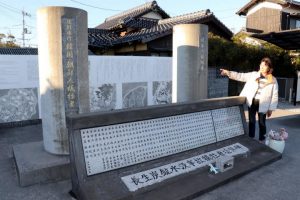Chosei coal mine disaster 82 years on — Remains of victims left buried at sea, Part 2: Civic group
Feb. 2, 2024
With annual gathering and establishment of memorial monument, group sets new goal of returning victims’ remains to families
by Minami Yamashita, Staff Writer
Following a walk of roughly ten minutes on a seaside road, overlooking what remains of the Chosei coal mine from a beach in Nishikiwa in Yamaguchi Prefecture’s Ube City, a sign reading “Chosei Coal Mine Disaster Memorial Square” comes into view.
A civic group working to memorialize the history of the Chosei coal mine flooding disaster developed the square and erected a monument on that spot in 2013, marking the 23rd anniversary of the group’s founding, to mourn the victims who drowned in the disaster that happened during World War II. Yoko Inoue, 73, the group’s co-chair, recalled that time. “Our group members felt accomplished. But we later realized how complacent we had been.”
Harsh comments from surviving families
The group was formed in 1991 of several individuals, including Takenobu Yamaguchi, a former high school teacher who had spent time researching the Chosei coal mine, based on its three goals of collecting materials and testimonies related to the disaster, preserving the mine’s pillars (cylindrical ventilation and drainage shafts from mine tunnels still standing at sea), and establishing a memorial monument. In the fall of that same year, an association of families of Korean victims was established after Mr. Yamaguchi’s group sent letters to people related to 118 of the 136 Korean victims, a number that makes up more than 70 percent of all of the disaster casualties. Each year since 1993, the group has held a memorial gathering around February 3, the date of the disaster anniversary, and invited the Korean families to Ube City.
Establishment of the square and the memorial monument modeling the pillars was achieved based on donations totaling around 16 million yen from members of the public. However, the group received unexpectedly caustic criticism from the surviving families in South Korea who questioned whether the group was thinking about ending its activities with that achievement and who also expressed their desire to have the victims’ remains returned to South Korea. It was then that the group set a new goal of exhuming the victims’ remains lying on the sea floor and returning them to their proper homes.
In 2015, two years after the monument was built, the group outsourced the work of identifying the location of the mine’s former entrance, which had been buried and closed after the war, to a specialist vendor in electrical exploration of underground cavities at a cost of about 1.5 million yen. As a result of the exploration work, the locations of the mine’s entrance and parts of its tunnels were successfully identified.
Group’s work passed on to younger generations
The group’s founder, Mr. Yamaguchi, has died. Now, among the roughly 500 members, Ms. Inoue is the only person who has participated in its activities since the group’s inception. “We hope to unearth from amidst the darkness the remains of the victims, who sadly died in the disaster, allow them to regain their dignity, and provide comfort to their bereaved families,” Ms. Inoue explained passionately.
The group’s hopes are being passed on to younger generations. In February of last year, as part of an exchange program organized by the Ube City civic group BIYP South Korea Youth Exchange Executive Committee, about 20 junior high school students from South Korea and around 20 junior high-school students in Japan participated in the memorial gathering.
Makoto Nagafuji, 19, one of the participants at the event, was at the time a third-year student at a high school in Yamaguchi City, which neighbors Ube City. “I grew aware of my own ignorance of history. Seeing the victims’ families, I felt as if the war had never ended.” Mr. Nagafuji is now studying at a university outside of Yamaguchi Prefecture with many international students. Aya Takenami, 15, a third-year junior high-school student from Ube City, joined the exchange event and the memorial gathering based on her familiarity with South Korea through “K-pop” music. With that experience, Ms. Takenami began to consider the importance of not only feeling affection for South Korea but also learning more about the history of the two countries. “We want to recover the remains of every single person. Young people must help in some way,” she said.
This year, the memorial gathering is once again scheduled to be held on February 3 at the memorial square. One year ago, a South Korean junior high-school student held up a message toward the sea where the victims lie. In both Japanese and South Korean, the sign read, “Looking forward to meeting you aboveground.”
(Originally published on February 2, 2024)








